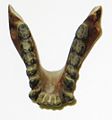Pliopithecus
| Pliopithecus | ||||||||||||
|---|---|---|---|---|---|---|---|---|---|---|---|---|

|
||||||||||||
| Temporal occurrence | ||||||||||||
| Miocene | ||||||||||||
| 17 to 11 million years | ||||||||||||
| Locations | ||||||||||||
|
||||||||||||
| Systematics | ||||||||||||
|
||||||||||||
| Scientific name | ||||||||||||
| Pliopithecus | ||||||||||||
| Gervais , 1849 | ||||||||||||
| species | ||||||||||||
|
||||||||||||
Pliopithecus is a fossil genus of primates from the Miocene . It existed around 17 to 11 million years ago. The species of the genus were - the previous According to findings - widely used in Europe and Asia, but not in Africa. Pliopithecus is - like Laccopithecus - a possible ancestor of today's gibbons .
Naming
Pliopithecus is an artificial word . "Plio" refers to the Pliocene , a section of the earth's history from which the fossil bones used for the first description in 1849 seemed to come. The second half of the generic name is derived from the Greek word πίθηκος ( pronounced in ancient Greek píthēkos : "monkey"). Pliopithecus therefore means "pliocene monkey".
features
Pliopithecus was only about 20 to 40 cm tall. Its appearance may have been reminiscent of a modern gibbon, although its arms were not as extremely long as the modern representatives. The diet of these primates was purely vegetarian, they ate leaves and fruits.
Finds
The first finds of the genus were discovered by Édouard Lartet near Sansan ( France ) in 1837 and published by him in 1851 - together with numerous other of his finds. In the following years and until recently, numerous other fossil finds were attributed to the genus and named as separate species, mostly on the basis of a few surviving fragments.
For example, the species Pliopithecus lockeri has been described using the fragment of a left lower jaw that came to light in Austria ; Pliopithecus piveteaui comes from France and has been described using a lower jaw with two preserved molars and ten individually found teeth; Pliopithecus hernyaki was described using a lower jaw with three preserved teeth, which were discovered in Rudabánya ( Hungary ); Pliopithecus krishnaii has been described using a single molar tooth discovered in India; In contrast, Pliopithecus vindobonensis , whose fossils were discovered in Czechoslovakia in the 1950s, is comparatively well documented : in addition to fragments of the upper and lower jaw and individual teeth, cranial bones and bones from the area below the skull have been preserved.
Lomorupithecus harrisoni and Laccopithecus robustus have morphological similarities with Pliopithecus antiquus .
literature
- KC Beard: Basal anthropoids in WC Hartwig (Ed.): The Primate Fossil Record. Cambridge University Press, Cambridge, England, 2002, xiv-530. Pp. 133-149.
- DR Begun: The Pliopithecoidea. In: WC Hartwig (Ed.): The Primate Fossil Record. Cambridge University Press, Cambridge, England, 2002, xiv-530. Pp. 221-240.
- RL Carroll: Vertebrate paleontology and evolution . WH Freeman and company, New York 1988, p. 698
- RL Carroll: Appendix. In: RL Carroll: Vertebrate paleontology and evolution. WH Freeman and company, New York 1988, pp. 594-648
- JG Fleagle : Primate adaption and evolution. Academic Press, New York 1988
- L. Ginsburg: Les faunes de mammifères terrestres du Miocène moyen des Faluns du bassin de Savigné-sur-lathan (France). In: Geodiversitas. Volume 23, No. 3, pp. 381-394
- MC McKenna and SK Bell (Eds.): Classification of mammals - above the species level. Columbia University Press, New York 1997, xii-631
- DT Rasmussen: Early catarrhines of the African Eocene and Oligocene. 203-220. In: WC Hartwig (Ed.): The Primate Fossil Record. Cambridge University Press, Cambridge, England, 2002, xiv-530
- EL Simons , P. Andrews and DR Pilbeam : Cenozoic apes. In: VJ Maglio and HBS Cooke (eds.): Evolution of African Mammals. Harvard University Press, Cambridge, Massachusetts, London, England, 1978, pp. 120-146.
Web links
- Description of Pliopithecus vindobonensis
- Reconstruction of the family tree of the genus Pliopithecus and its species ( Memento from April 2, 2007 in the Internet Archive )
- Images of finds
- Skeletal reconstruction
Individual evidence
- ^ Paul Gervais : Zoologie et paleontologie françaises (animaux vertébrés): ou nouvelles recherches sur les animaux vivants et fossiles de la France. Volume 1, p. 5. Arthus-Bertrand, Paris 1849. Online
- ^ Johannes Hürzeler : Contribution à l'odontologie et à la phylogénèse du genre Pliopithecus Gervais. In: Annales de Paléontologie. Volume 40, 1954, pp. 5-63
- ↑ Pliopithecus vindobonensis is also known as Epipliopithecus vindobonensis .
-
↑ David M. Alba et al .: A new species of Pliopithecus Gervais, 1849 (Primates: Pliopithecidae) from the Middle Miocene (MN8) of Abocador de Can Mata (els Hostalets de Pierola, Catalonia, Spain). In: American Journal of Physical Anthropology. Volume 141, No. 1, 2010, pp. 52-75, doi: 10.1002 / ajpa.21114
Discovery of a primate more than 11 million years old. On: eurekalert.org of April 21, 2010 - ^ David R. Begun: The Pliopithecoide. In: Walter Carl Hartwig (Ed.): The Primate Fossil Record. Cambridge University Press, Cambridge (UK) 2002, pp. 224-230, ISBN 0-521-66315-6 , full text
- ↑ Édouard Armand Lartet : Notice sur la colline de Sansan, suivie d'une récapitulation des diverses espèces d'animaux vertébrés fossiles, trouvés soit à Sansan, soit dans d'autres gisements du terrain tertiaire du miocène dans le bassin sous-pyrénéen. JA Portes, also 1851, online
- ↑ Rukang Wu and Yuerong Pan: The Hylobatidae from the late Miocene of Lufeng, Yunan. In: Acta Anthropologica Sinica. Volume 3, No. 3, 1984, pp. 185-194, full text with references to the first descriptions of the species
